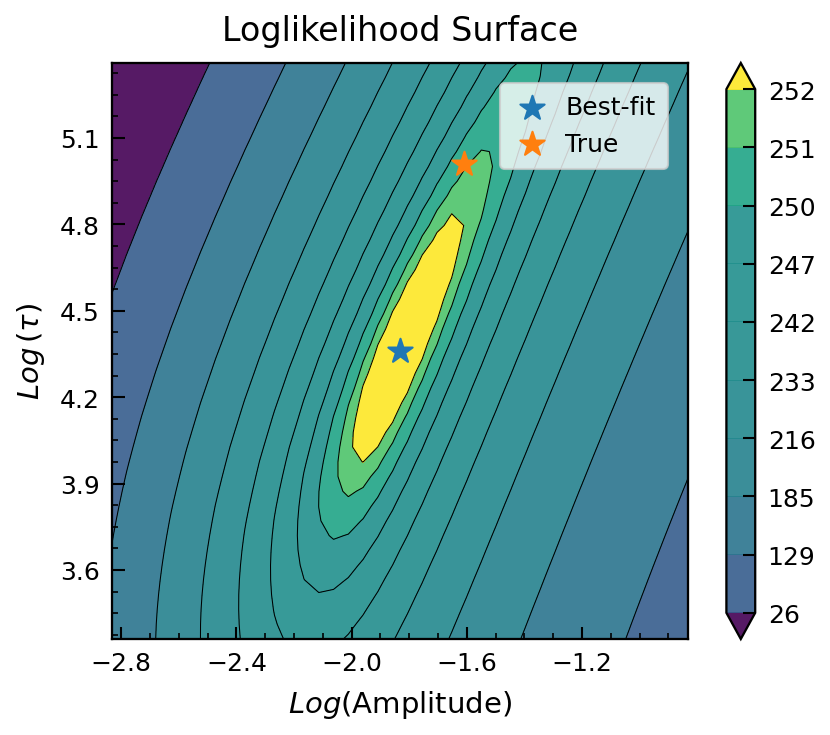Utility Functions¶
EzTao also provides a series of tools to help you model and understand time series data using CARMA. They are in two categories: visualization tools and functions to compute 2nd order statistics.
Visualization tools (eztao.viz.mpl_viz)¶
plot_pred_lc: Plotting the predicted time series given best-fit parameters conditioned on the input time series.plot_drw_ll: Plotting the log likelihood landscape of a DRW model.plot_dho_ll: Plotting the log likelihood landscape of a DHO/CARMA(2,0) model
[1]:
import numpy as np
from eztao.carma import DRW_term
from eztao.ts import gpSimRand
from eztao.ts import drw_fit
from eztao.viz import plot_pred_lc, plot_drw_ll
[2]:
# initialize a DRW kernel
amp = 0.2
tau = 150
DRW_kernel = DRW_term(np.log(amp), np.log(tau))
# simulate a process using the above model
SNR = 10
duration = 365*10.0
npts = 200
t, y, yerr = gpSimRand(DRW_kernel, SNR, duration, npts, log_flux=False)
# fit
best_fit = drw_fit(t, y, yerr)
print(f'Best-fit DRW parameter: {best_fit}')
Best-fit DRW parameter: [ 0.16008592 78.28325798]
[3]:
## plot predicted time series
t_pred = np.linspace(0, 365*6, 2000)
# get best-fit in CARMA space
best_fit_kernel = DRW_term(*np.log(best_fit))
best_fit_arma = best_fit_kernel.get_carma_parameter()
plot_pred_lc(t, y, yerr, best_fit_arma, 1, t_pred)

[4]:
## plot log likelihood surface
from eztao.ts import neg_param_ll
from celerite import GP
gp = GP(DRW_kernel, mean=np.median(y))
plot_drw_ll(t, y, yerr, best_fit, gp, neg_param_ll, true_params=[amp, tau])

2nd Order Statistics (eztao.carma.model_utils)¶
Given a valid CARMA kernel, you can generate 2nd order statistics at a range of timescales/frequencies. In this section, we will use a DHO/CARMA(2,1) model for demonstration. For a reference of how those statistics can be useful for analyzing time series data, feel free to check out Moreno et al. 2019.
PSD: Power spectrum density
ACF: Auto-correlation function
SF: Structure function
[5]:
from eztao.carma import CARMA_term
from eztao.carma import carma_acf, carma_psd, carma_sf
Create the PSD, ACF and SF functions given some DHO parameters
[6]:
ar = np.array([0.04, 0.0027941])
ma = np.array([0.004672, 0.0257])
psd = carma_psd(ar, ma)
acf = carma_acf(ar, ma)
sf = carma_sf(ar, ma)
Define a range of time scales and frequencies
[7]:
t = np.logspace(-1, 2.5, 1000)
t = np.insert(t, 0, 0)
freq = np.logspace(-5, 2)
Next, let’s try to plot them
[8]:
import matplotlib.pyplot as plt
[9]:
fig, ax = plt.subplots(3, 1, figsize=(6, 6), dpi=150)
ax[0].plot(t, acf(t), label='Autocorrelation')
ax[0].set_xlabel('Time (day)', size=10, labelpad=5)
ax[0].legend()
ax[1].plot(t, sf(t), label='Structure Function')
ax[1].set_xlabel('Time (day)', size=10, labelpad=5)
ax[1].set_xscale('log')
ax[1].set_yscale('log')
ax[1].set_ylim((10e-3, 1))
ax[1].legend()
ax[2].plot(freq, psd(freq), label='Power Spectrum Density')
ax[2].set_xlabel(r'Frequency ($\mathrm{\frac{1}{day}}$)', size=10, labelpad=5)
ax[2].set_xscale('log')
ax[2].set_yscale('log')
ax[2].legend()
fig.subplots_adjust(hspace=0.55)
